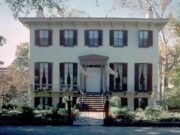The architect John Norris designed major public buildings and private residences in Savannah between 1846 and 1860. Skilled in a variety of mid-nineteenth-century revival styles, Norris became the city’s most important architect by the 1850s.
Born in 1804, John S. Norris began his career in his native New York City as a mason, progressed to a builder, and later identified himself as an architect in the New York City directory. In 1839 Norris sailed to Wilmington, North Carolina, where he supervised the construction of St. James Episcopal Church (1839), designed by the Philadelphia architect Thomas U. Walter. In 1843 Norris was appointed architect and superintendent of the Wilmington Custom House, his first major commission.
While working on the custom house in Wilmington, Norris received the commission to design the Savannah Custom House (1848–52), an austere Greek revival style building with a monumental portico. His work on the Custom House led to other commissions in Savannah. He designed the Andrew Low House (1849), the Massie School Building (1855; later the Massie Heritage Center); and the massive Abrahams Home for Indigent Females (1858). Norris designed his best-known house for Charles Green in the Gothic revival style. The Green-Meldrim House (1853), which is among the earliest Gothic revival houses in the state, is distinguished by its cast-iron porch and oriel windows. The interior features a profusion of Gothic-inspired plaster ornament around doors and windows, niches, and the dome that illuminates the spiral stair. In the Hugh Mercer House (1860–66) Norris designed a two-story brick Italianate-style dwelling with a classical entrance porch, decoratively sawn brackets along the eaves, and paired windows within segmental arches topped by heavy sculptural hoods.
Norris also designed towers to aid maritime navigation on shoals in the Savannah River and on Cockspur Island (1848–49). Among his last projects in the city were two brick Italianate-style warehouses built on the bluffs above the river. These warehouses are known as John Stoddard’s Lower Range (1858–59) and Upper Range (1859). In 1860, with the prospect of civil war, Norris returned to his family in New York City. Six years later, he moved to a farm at Blauvelt, in Rockland County, New York, where he remained until his death in 1876.




